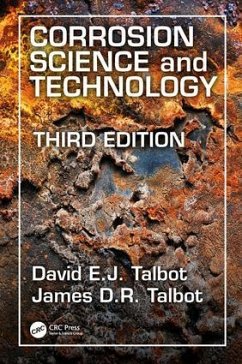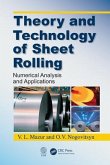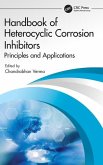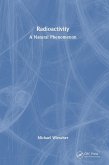- Gebundenes Buch
- Merkliste
- Auf die Merkliste
- Bewerten Bewerten
- Teilen
- Produkt teilen
- Produkterinnerung
- Produkterinnerung
This Third Edition thoroughly covers the basic principles of corrosion science a reader-friendly manner, and enlarges the scope of the content with expanded chapters on processes for various metals and new technologies for limiting costs and metal degradation in a variety of commercial enterprises not explored in previous editions.
Andere Kunden interessierten sich auch für
![Theory and Technology of Sheet Rolling Theory and Technology of Sheet Rolling]() V L MazurTheory and Technology of Sheet Rolling319,99 €
V L MazurTheory and Technology of Sheet Rolling319,99 €![Fuel Cell Technology Handbook Fuel Cell Technology Handbook]() Gregor Hoogers (ed.)Fuel Cell Technology Handbook251,99 €
Gregor Hoogers (ed.)Fuel Cell Technology Handbook251,99 €![Structural and Stress Analysis Structural and Stress Analysis]() Jianqiao YeStructural and Stress Analysis197,99 €
Jianqiao YeStructural and Stress Analysis197,99 €![Artificial Intelligence in Material Science Artificial Intelligence in Material Science]() Artificial Intelligence in Material Science186,99 €
Artificial Intelligence in Material Science186,99 €![Radioactivity Radioactivity]() Michael WiescherRadioactivity176,99 €
Michael WiescherRadioactivity176,99 €![Handbook of Heterocyclic Corrosion Inhibitors Handbook of Heterocyclic Corrosion Inhibitors]() Handbook of Heterocyclic Corrosion Inhibitors221,99 €
Handbook of Heterocyclic Corrosion Inhibitors221,99 €![Radioactivity Radioactivity]() Michael WiescherRadioactivity176,99 €
Michael WiescherRadioactivity176,99 €-
-
-
This Third Edition thoroughly covers the basic principles of corrosion science a reader-friendly manner, and enlarges the scope of the content with expanded chapters on processes for various metals and new technologies for limiting costs and metal degradation in a variety of commercial enterprises not explored in previous editions.
Hinweis: Dieser Artikel kann nur an eine deutsche Lieferadresse ausgeliefert werden.
Hinweis: Dieser Artikel kann nur an eine deutsche Lieferadresse ausgeliefert werden.
Produktdetails
- Produktdetails
- Verlag: CRC Press
- 3. Auflage
- Seitenzahl: 598
- Erscheinungstermin: 6. Februar 2018
- Englisch
- Abmessung: 260mm x 183mm x 36mm
- Gewicht: 1304g
- ISBN-13: 9781498752411
- ISBN-10: 1498752411
- Artikelnr.: 51126489
- Herstellerkennzeichnung
- Libri GmbH
- Europaallee 1
- 36244 Bad Hersfeld
- gpsr@libri.de
- Verlag: CRC Press
- 3. Auflage
- Seitenzahl: 598
- Erscheinungstermin: 6. Februar 2018
- Englisch
- Abmessung: 260mm x 183mm x 36mm
- Gewicht: 1304g
- ISBN-13: 9781498752411
- ISBN-10: 1498752411
- Artikelnr.: 51126489
- Herstellerkennzeichnung
- Libri GmbH
- Europaallee 1
- 36244 Bad Hersfeld
- gpsr@libri.de
David Talbot graduated with a B.Sc and an M.Sc. from the University of Wales and a Ph.D. from Brunel University for research on gas-metal equilibria. From 1949 to 1966, he was employed at the research laboratories of the British Aluminium Company Ltd., contributing to research promoting the development of manufacturing processes and to customer service. From 1966 to 1994, he taught courses on corrosion and other aspects of chemical metallurgy at Brunel University and maintained an active interest in research and development, mainly in collaboration with manufacturing industries in the United Kingdom and the United States. He was a member of the Institute of Materials and had chartered engineer status; he served as a member of the council of the London Metallurgical Society. Dr. Talbot wrote many papers on chemical aspects of metallurgy, a review on metal-hydrogen systems in International Metallurgical Reviews, and a section on gas-metal systems in Smithells Reference Book. James Talbot graduated with a B.Sc. ARCS, from Imperial College, London, and received his M.Sc. from Brunel University. He received his Ph.D. from the University of Reading for research on the physical chemistry of aqueous solutions and its application to natural waters. Dr. Talbot worked at the River Laboratory of the Institute of Freshwater Ecology, Dorset, United Kingdom, where he assessed and predicted physical chemical changes occurring in river management, He has written papers on the speciation of solutes in natural waters. From 2000 to 2006, he was a lecturer in materials research chemistry at Cranfield University in the United Kingdom, where he specialized in the physicochemical aspects of corrosion, polymer science, and process science. He is presently a chemist with interests in species specific corrosion mechanisms. Dr. Talbot is a current member of the Structure and Properties of Materials Committee of the Institute of Metals, Minerals and Mining. He has published in the fields of corrosion, polymer chemistry, solution chemistry, and the chemistry of natural waters.
Obituary. Preface to Third Edition. Overview of Corrosion and Protection
Strategies. Structures Participating in Corrosion Processes. Thermodynamics
and Kinetics of Corrosion Processes. Mixed Metal Systems. The Intervention
of Stress. Protective Coatings. Corrosion of Iron and Steels. Corrosion
Resistance of Stainless Steels. Corrosion Resistance of Aluminum and its
Alloys. Corrosion Resistance of Copper and its Alloys. Corrosion Resistance
of Nickel and Its Alloys. Corrosion Resistance of Titanium and its Alloys.
Corrosion Resistance of Zinc. Corrosion Resistance of Magnesium and its
Alloys. Corrosion Resistance of Tin and Tin Alloys. Corrosion Resistance of
Lead. Corrosion Resistance of Zirconium and Hafnium. Corrosion Resistance
of Beryllium. Corrosion Resistance of Uranium. Cathodic Protection.
Corrosion and Corrosion Control in Aviation. Corrosion Control in
Automobile Manufacture. Corrosion Control in Food Processing and
Distribution. Corrosion Control in Building Construction. Corrosion Control
in Marine Environments. Corrosion Control in Steam Raising by Fossil Fuels
for Power Generation. Some Corrosion Issues in Nuclear Engineering.
Oilfield Corrosion. The Role of Corrosion Testing. Prediction of Corrosion
Failures. Epilogue
Strategies. Structures Participating in Corrosion Processes. Thermodynamics
and Kinetics of Corrosion Processes. Mixed Metal Systems. The Intervention
of Stress. Protective Coatings. Corrosion of Iron and Steels. Corrosion
Resistance of Stainless Steels. Corrosion Resistance of Aluminum and its
Alloys. Corrosion Resistance of Copper and its Alloys. Corrosion Resistance
of Nickel and Its Alloys. Corrosion Resistance of Titanium and its Alloys.
Corrosion Resistance of Zinc. Corrosion Resistance of Magnesium and its
Alloys. Corrosion Resistance of Tin and Tin Alloys. Corrosion Resistance of
Lead. Corrosion Resistance of Zirconium and Hafnium. Corrosion Resistance
of Beryllium. Corrosion Resistance of Uranium. Cathodic Protection.
Corrosion and Corrosion Control in Aviation. Corrosion Control in
Automobile Manufacture. Corrosion Control in Food Processing and
Distribution. Corrosion Control in Building Construction. Corrosion Control
in Marine Environments. Corrosion Control in Steam Raising by Fossil Fuels
for Power Generation. Some Corrosion Issues in Nuclear Engineering.
Oilfield Corrosion. The Role of Corrosion Testing. Prediction of Corrosion
Failures. Epilogue
Obituary. Preface to Third Edition. Overview of Corrosion and Protection
Strategies. Structures Participating in Corrosion Processes. Thermodynamics
and Kinetics of Corrosion Processes. Mixed Metal Systems. The Intervention
of Stress. Protective Coatings. Corrosion of Iron and Steels. Corrosion
Resistance of Stainless Steels. Corrosion Resistance of Aluminum and its
Alloys. Corrosion Resistance of Copper and its Alloys. Corrosion Resistance
of Nickel and Its Alloys. Corrosion Resistance of Titanium and its Alloys.
Corrosion Resistance of Zinc. Corrosion Resistance of Magnesium and its
Alloys. Corrosion Resistance of Tin and Tin Alloys. Corrosion Resistance of
Lead. Corrosion Resistance of Zirconium and Hafnium. Corrosion Resistance
of Beryllium. Corrosion Resistance of Uranium. Cathodic Protection.
Corrosion and Corrosion Control in Aviation. Corrosion Control in
Automobile Manufacture. Corrosion Control in Food Processing and
Distribution. Corrosion Control in Building Construction. Corrosion Control
in Marine Environments. Corrosion Control in Steam Raising by Fossil Fuels
for Power Generation. Some Corrosion Issues in Nuclear Engineering.
Oilfield Corrosion. The Role of Corrosion Testing. Prediction of Corrosion
Failures. Epilogue
Strategies. Structures Participating in Corrosion Processes. Thermodynamics
and Kinetics of Corrosion Processes. Mixed Metal Systems. The Intervention
of Stress. Protective Coatings. Corrosion of Iron and Steels. Corrosion
Resistance of Stainless Steels. Corrosion Resistance of Aluminum and its
Alloys. Corrosion Resistance of Copper and its Alloys. Corrosion Resistance
of Nickel and Its Alloys. Corrosion Resistance of Titanium and its Alloys.
Corrosion Resistance of Zinc. Corrosion Resistance of Magnesium and its
Alloys. Corrosion Resistance of Tin and Tin Alloys. Corrosion Resistance of
Lead. Corrosion Resistance of Zirconium and Hafnium. Corrosion Resistance
of Beryllium. Corrosion Resistance of Uranium. Cathodic Protection.
Corrosion and Corrosion Control in Aviation. Corrosion Control in
Automobile Manufacture. Corrosion Control in Food Processing and
Distribution. Corrosion Control in Building Construction. Corrosion Control
in Marine Environments. Corrosion Control in Steam Raising by Fossil Fuels
for Power Generation. Some Corrosion Issues in Nuclear Engineering.
Oilfield Corrosion. The Role of Corrosion Testing. Prediction of Corrosion
Failures. Epilogue

